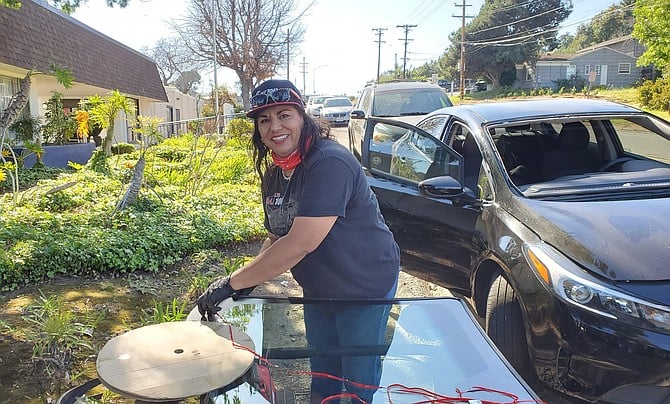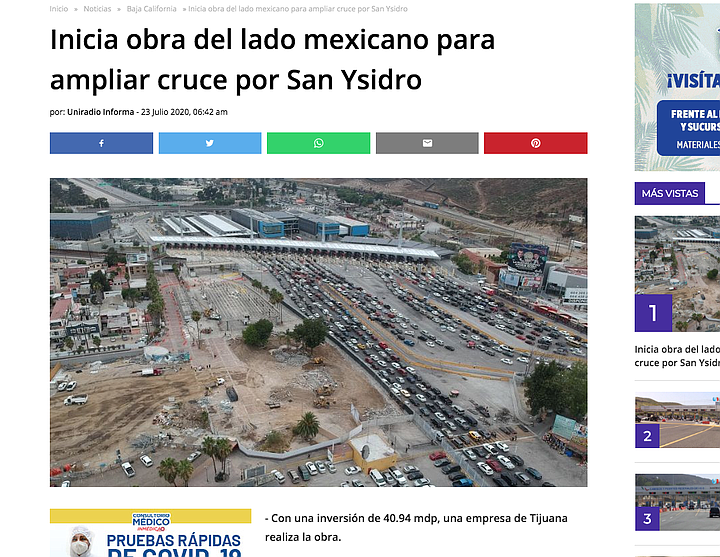 Facebook
Facebook
 X
X
 Instagram
Instagram
 TikTok
TikTok
 Youtube
Youtube

On July 23, construction in Tijuana commenced of the eight lanes leading into the San Ysidro Port of Entry.
“With this expansion we will be reaching 35 lanes, and what will that consist of?” reportedly said Jesús Felipe Verdugo López, general manager of the Secretaría de Comunicaciones y Transportes in Baja California. “It is to rebuild the sanitary drainage, the rainwater drainage, to reinstall the public lighting, and to build a rolling slab that will be around 25 centimeters of rigid concrete slab, and below that a base stabilized with cement.”
The $1.8 million upgrade will reportedly speed up the wait times driving back into the U.S. by 25-30 percent.

On July 28, the “border wait times” section of the U.S. Customs and Border Protection website states that the general lanes wait time at midnight was about 2.5 hours which is about 30 more minutes than usual; at 7 am, when many motorists crossed to come to work in San Diego, wait time was 2 hours which is about 30 minutes more than normal. In the ready lanes, where adult travelers over 16 years of age are required to have high-tech RFID enabled cards: RFID enabled U.S. Passport cards, Legal Permanent Resident cards, B1/B2 border crossing cards, Sentri cards and Enhanced Driver’s Licenses — wait time at midnight and 7 am were about 1.5 hours where normally it should’ve taken about an hour. On the Sentri lanes at midnight, commuters crossed in about five minutes; at 7 am it took motorists about 15 minutes to cross.
“I’m thinking of getting a Sentri pass,” said Y. Stover from Alpine. “I have Ready Lane [documentation], but sometimes when they close many lanes, it can be brutal and take 5 hours to cross. A Sentri pass is not that expensive, I think it’s like $122.50 for 5 years.”
Stover is an off-road racer and manages a windshield repair and installation business in Alpine; she travels back and forth on a regular basis.

“They are doing a great job expanding the border: the expansion is at the old entrance (“Puerta México”) into Tijuana, so it’s on the left side if you’re driving across.”
Stover then sent me a screenshot from the Uniradioinforma.com July 23 news report of the eight lane expansion.
“You can see, they already have the booths ready,” she continued.
“They (the U.S.) inspire us that they have not forgotten us at the border,” reportedly said Aram Hodoyan Navarro, president of the Consejo de Desarrollo de Tijuana (Tijuana Development Council) “That even in these hard times that we know the country is going through, they dedicate resources to the border ….”
According to the U.S. General Service Administration website, San Ysidro Land Port of Entry is the busiest land port of entry in the western hemisphere, each day processing about 70,000 northbound vehicles and 20,000 northbound pedestrians. The site states that the U.S. spent about $741 million expanding and enhancing the port since 2011, and completed Phase 3 last winter, which included the southbound I-5 realignment and the northbound vehicular inspection areas.
There’s no mention of an estimated time of completion of lanes leading in from Tijuana.
“I don’t think it's going to save time crossing the border,” opined Pedro Vargas from Tijuana. “The bottleneck is before the border crossing into the U.S.”
Vargas is a former Baja 1000 participant, and founder of the San Pedro Mártir Hill Climb race in Ensenada; he analyzes roadways and terrains for his race car drivers that trek in from all parts of the U.S.
“The northbound motorists all have to come and converge into two lanes.”
M. Valdez is a San Diego street racer that’ll attend Vargas’s race in October.
“Every time I cross back into the U.S., the minute they open up one or two new lanes, the traffic moves faster because the people in the slow lanes move into the faster lanes,” Valdez said. “Now imagine opening eight lanes of traffic — I think it’s going to flow much faster for us, even when trailering our toys.”
Verdugo López reportedly added: “What else does [the construction] include? A system that we call wi-fi is included, which is [implemented] to measure waiting times. A person who comes from anywhere in the city in real time, can assess how long they will wait to pass, and can make the decision to cross San Ysidro, or cross at Otay.”
“That’s awesome,” Valdez said, “our phone service is shoddy when we wait to cross. We can [hopefully] get wi-fi and upload and stream our new race videos onto our social media.”


On July 23, construction in Tijuana commenced of the eight lanes leading into the San Ysidro Port of Entry.
“With this expansion we will be reaching 35 lanes, and what will that consist of?” reportedly said Jesús Felipe Verdugo López, general manager of the Secretaría de Comunicaciones y Transportes in Baja California. “It is to rebuild the sanitary drainage, the rainwater drainage, to reinstall the public lighting, and to build a rolling slab that will be around 25 centimeters of rigid concrete slab, and below that a base stabilized with cement.”
The $1.8 million upgrade will reportedly speed up the wait times driving back into the U.S. by 25-30 percent.

On July 28, the “border wait times” section of the U.S. Customs and Border Protection website states that the general lanes wait time at midnight was about 2.5 hours which is about 30 more minutes than usual; at 7 am, when many motorists crossed to come to work in San Diego, wait time was 2 hours which is about 30 minutes more than normal. In the ready lanes, where adult travelers over 16 years of age are required to have high-tech RFID enabled cards: RFID enabled U.S. Passport cards, Legal Permanent Resident cards, B1/B2 border crossing cards, Sentri cards and Enhanced Driver’s Licenses — wait time at midnight and 7 am were about 1.5 hours where normally it should’ve taken about an hour. On the Sentri lanes at midnight, commuters crossed in about five minutes; at 7 am it took motorists about 15 minutes to cross.
“I’m thinking of getting a Sentri pass,” said Y. Stover from Alpine. “I have Ready Lane [documentation], but sometimes when they close many lanes, it can be brutal and take 5 hours to cross. A Sentri pass is not that expensive, I think it’s like $122.50 for 5 years.”
Stover is an off-road racer and manages a windshield repair and installation business in Alpine; she travels back and forth on a regular basis.

“They are doing a great job expanding the border: the expansion is at the old entrance (“Puerta México”) into Tijuana, so it’s on the left side if you’re driving across.”
Stover then sent me a screenshot from the Uniradioinforma.com July 23 news report of the eight lane expansion.
“You can see, they already have the booths ready,” she continued.
“They (the U.S.) inspire us that they have not forgotten us at the border,” reportedly said Aram Hodoyan Navarro, president of the Consejo de Desarrollo de Tijuana (Tijuana Development Council) “That even in these hard times that we know the country is going through, they dedicate resources to the border ….”
According to the U.S. General Service Administration website, San Ysidro Land Port of Entry is the busiest land port of entry in the western hemisphere, each day processing about 70,000 northbound vehicles and 20,000 northbound pedestrians. The site states that the U.S. spent about $741 million expanding and enhancing the port since 2011, and completed Phase 3 last winter, which included the southbound I-5 realignment and the northbound vehicular inspection areas.
There’s no mention of an estimated time of completion of lanes leading in from Tijuana.
“I don’t think it's going to save time crossing the border,” opined Pedro Vargas from Tijuana. “The bottleneck is before the border crossing into the U.S.”
Vargas is a former Baja 1000 participant, and founder of the San Pedro Mártir Hill Climb race in Ensenada; he analyzes roadways and terrains for his race car drivers that trek in from all parts of the U.S.
“The northbound motorists all have to come and converge into two lanes.”
M. Valdez is a San Diego street racer that’ll attend Vargas’s race in October.
“Every time I cross back into the U.S., the minute they open up one or two new lanes, the traffic moves faster because the people in the slow lanes move into the faster lanes,” Valdez said. “Now imagine opening eight lanes of traffic — I think it’s going to flow much faster for us, even when trailering our toys.”
Verdugo López reportedly added: “What else does [the construction] include? A system that we call wi-fi is included, which is [implemented] to measure waiting times. A person who comes from anywhere in the city in real time, can assess how long they will wait to pass, and can make the decision to cross San Ysidro, or cross at Otay.”
“That’s awesome,” Valdez said, “our phone service is shoddy when we wait to cross. We can [hopefully] get wi-fi and upload and stream our new race videos onto our social media.”
Comments